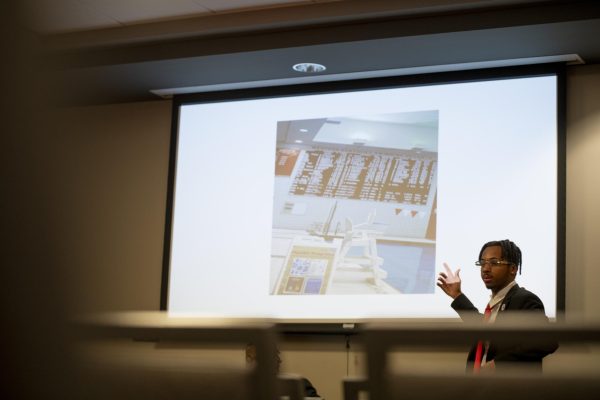Reagan-era economist Art Laffer to speak at WKU
March 24, 2016
Today, WKU will host a presentation featuring economist Arthur Laffer, who was a member of former President Ronald Reagan’s Economic Policy Advisory Board.
Cathy Carey, the head of the economics department, said Laffer’s presentation will give students a chance to hear from a leading economist.
“I think this is a great opportunity for students to hear [Laffer] and just be able to directly relate it to something they talked about in their macroeconomics class,” Carey said.
Laffer rose to prominence when he served on Reagan’s Economic Policy Advisory Board from 1981 to 1989. Referred to as “the father of supply-side economics,” he is most famous for the Laffer curve, a theory that focuses on the relationship between tax rates and tax revenue.
The curve suggests that increasing tax rates after a certain point will only decrease the amount of tax revenue the government receives. It has been used to support tax cuts, which were especially common during the Reagan administration.
Carey said the curve shows lower tax rates can lead to an increase in tax revenue. Lower taxes encourage people to spend more money because they know they will not lose a significant amount of money to taxes. People are also more apt to work because they want to earn more money to spend.
The Laffer curve — and Laffer himself — have sparked criticism among some economists. Portrayed as a staunch conservative and libertarian, Laffer’s theory has been denied by a number of economists, notably those who tend to be more liberal.
Joe Glaser, professor emeritus of English, said he had concerns about the presentation, particularly because of Laffer’s bias towards primarily conservative ideas.
“Today, Laffer is not very popular except among hard-right conservatives,” Glaser said in an email. “He’s also an extreme partisan, not a dispassionate scholar by any means.”
In his emails, Glaser, who noted he is not an economist, included several studies which he said showed that a “majority” of economists had discredited the Laffer curve.
“I certainly don’t object to Laffer being invited by conservatives to present their views on campus,” Glaser said, “but I don’t think he should be presented as a respected economist or an unbiased expert.”
Laffer’s presentation is sponsored by a number of organizations. The economics department and the WKU BB&T Center for the Study of Capitalism are two sponsors.
Brian Strow, associate professor of economics, said he invited Laffer to speak because of Laffer’s experience with the views promoted by the WKU BB&T Center.
“I try to find people who are interested in promoting voluntary exchange, free markets or capitalism generally,” Strow said.
The WKU BB&T Center, located in the Gordon Ford College of Business, promotes the study of capitalism.
“We’re trying to teach students the moral benefits of voluntary exchange,” Strow said.
Strow said the WKU BB&T Center was founded several years ago when the BB&T banking group gave WKU $1 million over 10 years to fund a center that would promote capitalism.
In addition to the WKU BB&T Center, the Charles G. Koch Foundation and the Young America’s Foundation are also sponsors.
The Charles G. Koch Foundation, part of the Koch Family Foundations, is a nonprofit organization. It seeks to promote the idea of a free market economy, which the foundation refers to as a “free society.”
According to the foundation’s website, money has been given to organizations such as the Cato Institute, a well-known libertarian think-tank.
In Kentucky, the foundation has also given money to the University of Louisville and the University of Kentucky to fund institutes to teach free market concepts at both universities.
On its website, the Young America’s Foundation defines itself as “the principal outreach organization of the Conservative Movement.” The foundation seeks to help students promote conservative ideas by helping students bring speakers to their schools.
Carey said although there is a school of thought that disagrees with the Laffer curve, there is another school of thought that supports the theory.
“There are two predominant economic aisles just like there are predominant political aisles, and so you have economists on one side and economists on the other,” Carey said. “The one side will say it discredited the other, and the other side feels differently.”
Carey said many of the studies Glaser provided in his email ask questions that do not apply to the Laffer curve, and she considers these studies unreliable. Carey said the curve is one of “the most easily understood yet one of the most widely misunderstood concepts” in macroeconomics, and many of these studies display a lack of understanding about the Laffer curve.
Carey also said many of Laffer’s critics tend to focus solely on the Laffer curve while ignoring his impact on other areas of economics.
“He’s famous for the Laffer curve, but that’s just one portion of his research,” Carey said. “He is known as ‘the father of supply-side economics,’ which focuses on the ability to use tax policy to incentivize productive activity.”
The BB&T Center has an ongoing speaker series, and Laffer was invited to be one of two guests to speak at WKU during the spring semester. He will speak about policies that would improve and speed up economic growth.
The presentation will be held in the Downing Student Union auditorium at 8 p.m. Thursday. Strow said he expects Laffer to speak for about 45 minutes followed by a question and answer session.
The free event is open to the WKU community and the public, and a live stream of the event will be available.

























